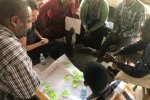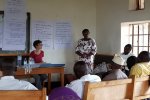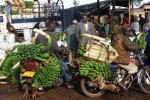
Nieuws
Exploring transformative pathways for the banana value chain in Uganda
Improving productivity alone is often not enough for farmers to adopt sustainable intensification practices. Establishing links with input and output markets is indispensable. The STEP-UP project combines sustainable intensification of farming systems with a value chain approach to provide such linkages. Through participatory scenario development and impact assessment we aim at discussing and converging the views of different stakeholders along the value chain, to identify the most promising interventions enabling (agricultural) transformation pathways towards such a future.
The STEP-UP project works on mango value chains in Kenya, and cooking banana value chains in Uganda. Two weeks ago, a participatory visioning and backcasting workshop was held in southwestern Uganda, one of the two sites that the project will focus on in the country. The aim of this workshop was to establish a shared vision for the cooking banana value chain in Uganda, to identify the steps needed to reach that vision, and to select relevant indicators that could measure the project’s progress towards the vision. Stakeholders participating in the workshop included farmers, representatives of cooperatives and unions, extension officers, processors (wine, cakes), researchers, financial institutes and local government representatives.
The workshop started with an overview of past trends and drivers of change. The southwest of Uganda is dominated by intensified banana production. Farmers value the commercial importance of the crop, but with increasing pressure on soil fertility and natural resources the sustainability of the system is questionable. For the vision of the future of banana in the area we therefore took into account different aspects of sustainability (economic, food security, environmental and social).
Stakeholders jointly expressed their wish for increased processing and value addition of banana and bi-products like banana peels, improved knowledge about the application of good agricultural practices, reduced vulnerability to drought and improved functioning of cooperatives. Potential interventions that could contribute to reaching this vision included exchange visits to other demonstration sites of the closely related project on banana agronomy (where PPS is also involved), improved recycling of banana waste products, improved packaging of banana (with farmers receiving a premium price while reducing post-harvest losses), establishment of a grading system based on quality and weight of bunches and the joint collection and transport of banana at the cooperative level.
As a next step, two value chain interventions will be selected for implementation. At PPS, we will also conduct an ex ante impact assessment of these two interventions, which we will compare with two more transformative changes (pathways). We will assess the current situation for different types of farmers on locally-relevant indicators in the four sustainability domains, and then assess the effect of the pathways on these same households in 20 years’ time. We will consider the effect of these pathways under different scenarios in relation to changes in climate, market and specialization of banana production. A similar exercise will be done for the second site in western Uganda, characterized by a more diversified farming system, and the mango value chain in Kenya.


